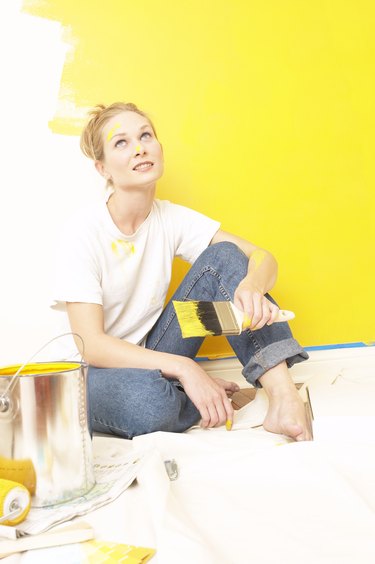
Painting over glossy paint is not that different from painting over flat or semi-gloss paint. The goal is to get the new paint to stick without having to completely remove the glossy paint, which new paint usually doesn't adhere to without preparation. After prepping the area, you clean the walls, then sand them. After sanding the walls, apply primer to help the paint stick to the walls, painting them after the primer dries.
Preparing the Room
Video of the Day
Remove everything you can from the room. Turn off the electricity to the house or room in question. Remove all light fixtures, ceiling fans and switch or outlet cover plates. Put masking or painter's tape tape over any exposed switches, outlets or wiring. Move anything too big to take out into the center of the room and cover it with a drop cloth or plastic to protect it from getting sanding dust or paint on it. Cover the floors and trim using plastic or drop cloths, taping the edges with masking tape to ensure no paint drips behind the cloth.
Video of the Day
First Wash
Wash the walls using a wet rag and a rinse-free cleaning solution. This step removes any grime, dirt, dust or oil on the wall. You need to wash it again after sanding, so this first wash doesn't need to be extensive, so long as you cover the entire surface. Be sure to remove any visible marks or stains during this first wash.
Repairing and Sanding
Before sanding, fill any small holes or inconsistencies with filler compound and a putty knife. Follow the instructions on the filler's packaging and give the filler plenty of time to dry before sanding. While sanding a wall before you paint it generally is a good idea for any type of paint, it is crucial when painting over high-gloss paint. Since glossy paint is not very adhesive, sanding gives the new paint something to latch on to, which makes the paint job stick. Use a fine-grit sandpaper and lightly sand; do not to sand hard enough to damage the wall beneath the paint.
Second Wash
Re-wash the walls to remove any sand or dust created by sanding. You need to be thorough with this washing. Consider vacuuming the floors and walls before washing to ensure more dust is not kicked up onto the walls while washing.
Priming and Painting
Priming the walls before applying the finishing coat helps seal the walls and add uniformity to the paint job. Use a primer designed for the type of paint you will use. For example, if you are using an oil-based paint, use an oil-based primer or one designed to work with oil-based paint. Since primers differ, follow the instructions that come with the product to achieve ideal results. After letting the primer dry for the amount of time specified in the product's instructions, you're ready to paint. Like the primer, follow any instructions provided with the paint, which often is on the can.